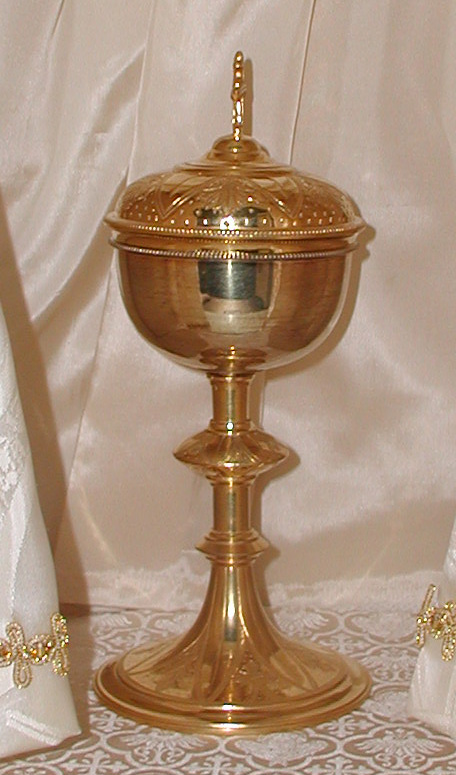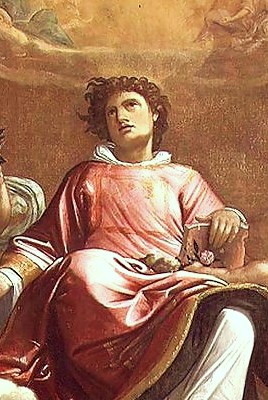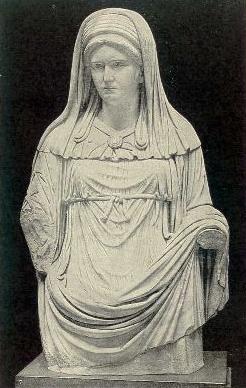|
Credence Table
A credence table is a small side table in the sanctuary of a Christian church which is used in the celebration of the Eucharist (Latin ''credens, -entis'', believer). The credence table is usually placed near the wall on the epistle (south) side of the sanctuary, and may be covered with a fine linen cloth. It is sometimes tended by an acolyte or altar server, and contains on it the implements that are used in the Eucharistic celebration, which may include the bread and wine prior to their consecration, a bowl, perforated spoon, ewer and towel for the lavabo and the ablutions after Holy Communion, etc. The wafers for the communion of the faithful may be stored in a ciborium, or host box (sometimes erroneously referred to as a pyx). The wine and water for the chalice will be in cruets. The chalice, and paten, covered with their cloths and veil (see chalice cloths for details) may be placed on the credence from the beginning of the service until the Offertory, at which ... [...More Info...] [...Related Items...] OR: [Wikipedia] [Google] [Baidu] |
Ciborium (container)
A ciborium (plural ciboria; Medieval Latin ''ciborium'' "drinking cup", from the Ancient Greek κιβώριον ''kibōrion'', "drinking cup"OED.) is a vessel, normally in metal. It was originally a particular shape of drinking cup in ancient Greece and Rome, but the word later came to refer to a large covered cup designed to hold hosts for, and after, the Eucharist, thus the counterpart (for the bread) of the chalice (for the wine). The word is also used for a large canopy over the altar of a church, which was a common feature of Early Medieval church architecture, now relatively rare. History The ancient Greek word referred to the cup-shaped seed vessel of the Egyptian water-lily '' nelumbium speciosum'' and came to describe a drinking cup made from that seed casing, or in a similar shape. These vessels were particularly common in ancient Egypt and the Greek East. The word "ciborium" was also used in classical Latin to describe such cups, although the only example to have s ... [...More Info...] [...Related Items...] OR: [Wikipedia] [Google] [Baidu] |
Altar
An altar is a table or platform for the presentation of religion, religious offerings, for sacrifices, or for other ritualistic purposes. Altars are found at shrines, temples, Church (building), churches, and other places of worship. They are used particularly in Christianity, Buddhism, Hinduism, and modern paganism. Many historical-medieval faiths also made use of them, including the Religion in ancient Rome, Roman, Religion in ancient Greece, Greek, and Norse paganism, Norse religions. Etymology The modern English language, English word ''wikt:altar#English, altar'' was derived from Middle English ''wikt:alter#Latin, altar'', from Old English ''wikt:alter, alter'', taken from Latin ''wikt:altare#Latin, altare'' ("altar"), probably related to ''wikt:adolere#Etymology 2, adolere'' ("burn"); thus "burning place", influenced by ''wikt:altus#Latin, altus'' ("high"). It displaced the native Old English word ''wikt:weofod#Old English, wēofod''. Altars in antiquity In antiquity, alta ... [...More Info...] [...Related Items...] OR: [Wikipedia] [Google] [Baidu] |
Priest
A priest is a religious leader authorized to perform the sacred rituals of a religion, especially as a mediatory agent between humans and one or more deity, deities. They also have the authority or power to administer religious rites; in particular, rites of sacrifice to, and propitiation of, a deity or deities. Their office or position is the "priesthood", a term which also may apply to such persons collectively. A priest may have the duty to hear confessions periodically, give marriage counseling, provide prenuptial counseling, give spiritual direction, teach catechism, or visit those confined indoors, such as the sick in hospitals and nursing homes. Description According to the trifunctional hypothesis of prehistoric Proto-Indo-European society, priests have existed since the earliest of times and in the simplest societies, most likely as a result of agricultural surplus#Neolithic, agricultural surplus and consequent social stratification. The necessity to read sacred text ... [...More Info...] [...Related Items...] OR: [Wikipedia] [Google] [Baidu] |
Deacon
A deacon is a member of the diaconate, an office in Christian churches that is generally associated with service of some kind, but which varies among theological and denominational traditions. Major Christian denominations, such as the Catholic Church, the Oriental Orthodox Churches, the Eastern Orthodox Church, Lutheranism, Presbyterianism, Methodism, and Anglicanism, view the diaconate as an order of ministry. Permanent deacons (or distinctive deacons) are those who do not later transition to another form of ministry, in contrast to those continuing their formation who are then often called transitional deacons. Origin and development The word ''deacon'' is derived from the Greek word (), which is a standard ancient Greek word meaning "servant", "waiter", "minister", or "messenger". Recent research has highlighted the role of the deacon "as a co-operator" and "go-between," emphasizing their intermediary position in early Christian communities. It is generally assum ... [...More Info...] [...Related Items...] OR: [Wikipedia] [Google] [Baidu] |
Tridentine Mass
The Tridentine Mass, also known as the Extraordinary Form of the Roman Rite or ''usus antiquior'' (), Vetus Ordo or the Traditional Latin Mass (TLM) or the Traditional Rite, is the liturgy in the Roman Missal of the Catholic Church codified in 1570 and published thereafter with amendments up to 1962. Celebrated almost exclusively in Ecclesiastical Latin, it was the most widely used Eucharistic liturgy in the world from its issuance in 1570 until its replacement by the Mass of Paul VI promulgated in 1969 (with the revised Roman Missal appearing in 1970.) "Tridentine" is derived from the Latin ''Tridentinus'', "related to the city of Trent", where the Council of Trent was held at the height of the Counter-Reformation. In response to a decision of that council, Pope Pius V promulgated the 1570 Roman Missal, making it mandatory throughout the Latin Church, except in places and religious orders with rites or uses from before 1370. Permissions for celebrating the Tridentine Mass ... [...More Info...] [...Related Items...] OR: [Wikipedia] [Google] [Baidu] |
Low Mass
Low Mass (Latin ''Missa Privata'') is a Mass celebrated by a priest without the assistance of sacred ministers (deacon and subdeacon). Before the 1969 reforms, a sub-distinction was also made between the '' sung Mass'' (), when the celebrant still chants those parts which the rubrics require to be chanted, and the ''low Mass'' () where the liturgy is spoken. In a low Mass, the priest may be assisted by altar boys ( acolytes) rather than deacons, and use appropriately simplified rubrics. A full sung Mass celebrated with the assistance of sacred ministers is a High or Solemn Mass. The celebration of Low Mass occurred in the Roman Rite, prior to the 1969 reforms in the Catholicism, and continues in Lutheranism, as well as parts of Anglicanism. History Low Mass originated in the early Middle Ages as a shortened or simplified form of Solemn Mass. In the early church, as in the Eastern Orthodox church today, all services were chanted, and there was no equivalent to the Roman Low ... [...More Info...] [...Related Items...] OR: [Wikipedia] [Google] [Baidu] |
Mass (liturgy)
Mass is the main Eucharistic liturgical service in many forms of Western Christianity. The term ''Mass'' is commonly used in the Catholic Church, Western Rite Orthodoxy, Old Catholicism, and Independent Catholicism. The term is also used in many Lutheran churches, as well as in some Anglican churches, and on rare occasion by other Protestant churches. Other Christian denominations may employ terms such as '' Divine Service'' or '' worship service'' (and often just "service"), rather than the word ''Mass''. For the celebration of the Eucharist in Eastern Christianity, including Eastern Catholic Churches, other terms such as ''Divine Liturgy'', ''Holy Qurbana'', ''Holy Qurobo'' and ''Badarak'' (or ''Patarag'') are typically used instead. Etymology The English noun ''Mass'' is derived from the Middle Latin . The Latin word was adopted in Old English as (via a Vulgar Latin form ), and was sometimes glossed as ''sendnes'' (i.e. 'a sending, dismission'). The Latin term itself w ... [...More Info...] [...Related Items...] OR: [Wikipedia] [Google] [Baidu] |
Roman Rite
The Roman Rite () is the most common ritual family for performing the ecclesiastical services of the Latin Church, the largest of the ''sui iuris'' particular churches that comprise the Catholic Church. The Roman Rite governs Rite (Christianity), rites such as the Roman Mass and the Liturgy of the Hours as well as the manner in which Sacraments of the Catholic Church, sacraments and Blessing in the Catholic Church, blessings are performed. The Roman Rite developed in the Latin language in the city of Rome and, while distinct Latin liturgical rites such as the Ambrosian Rite remain, the Roman Rite has gradually been adopted almost everywhere in the Latin Church. In medieval times there were numerous local variants, even if all of them did not amount to distinct rites, yet uniformity increased as a result of the invention of printing and in obedience to the decrees of the Council of Trent of 1545–1563 (see ''Quo primum''). Several Latin liturgical rites which had survived into th ... [...More Info...] [...Related Items...] OR: [Wikipedia] [Google] [Baidu] |
Offertory
The offertory (from Medieval Latin ''offertorium'' and Late Latin ''offerre'') is the part of a Eucharistic service when the bread and wine for use in the service are ceremonially placed on the altar. A collection of alms (offerings) from the congregation, which may take place also at non-Eucharistic services, often coincides with this ceremony. The Eucharistic theology may vary among those Christian denominations that have a liturgical offertory. In the Roman Rite, the term "Preparation of the Gifts" is used in addition to the term "Offertory" (both capitalized) or, rather, the term "Preparation of the Gifts" is used for the action of the priest, while the term "Offertory" is used for the section of the Mass at which this action is performed in particular when speaking of the accompanying chant. In the Lutheran Mass, the Offertory includes the presentation of the eucharistic gifts at the altar by the churchwardens, the bringing up of the collection to the altar, and the praye ... [...More Info...] [...Related Items...] OR: [Wikipedia] [Google] [Baidu] |
Altar Cloth
An altar cloth is used in the Christian liturgy to cover the altar. It serves as a sign of reverence as well as a decoration and a protection of the altar and the sacred vessels. In the orthodox churches it is covered by the antimension, which also contains the relics of saints. Since the 2nd century the altar cloth has been seen as a symbol for the shroud of Jesus Christ; therefore it should be made of white linen. Another interpretation used two cloths and compared them with the body and soul of Christ. Christian altar cloths Western Churches Special cloths (not necessarily made of linen) cover the altar in many Christian churches during services and celebrations, and are often left on the altar when it is not in use. In the early 20th century the Catholic Church considered only linen or hemp to be acceptable as material for altar cloths, although in earlier centuries silk or cloth of gold or silver were used. The Anglican Communion had similar rules in that period. At ... [...More Info...] [...Related Items...] OR: [Wikipedia] [Google] [Baidu] |
Veil
A veil is an article of clothing or hanging cloth that is intended to cover some part of the human head, head or face, or an object of some significance. Veiling has a long history in European, Asian, and African societies. The practice has been prominent in different forms in Judaism, Christianity, and Islam. The practice of veiling is especially associated with women and sacred objects, though in some cultures, it is men, rather than women, who are expected to wear a veil. Besides its enduring religious significance, veiling continues to play a role in some modern secular contexts, such as wedding customs. History Antiquity Elite women in ancient Mesopotamia and in the Rise of Macedon, Macedonian and Persian Empire, Persian empires wore the veil as a sign of respectability and high status. The earliest attested reference to veiling is found a Middle Assyrian Empire, Middle Assyrian law code dating from between 1400 and 1100 BC. Assyria had explicit sumptuary laws detailin ... [...More Info...] [...Related Items...] OR: [Wikipedia] [Google] [Baidu] |









